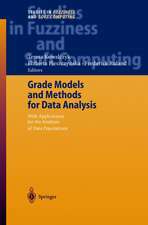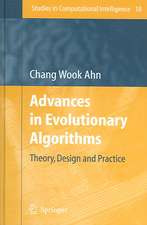Fuzzy Choice Functions: A Revealed Preference Approach: Studies in Fuzziness and Soft Computing, cartea 214
Autor Irina Georgescuen Limba Engleză Hardback – 26 apr 2007
| Toate formatele și edițiile | Preț | Express |
|---|---|---|
| Paperback (1) | 640.37 lei 6-8 săpt. | |
| Springer Berlin, Heidelberg – 18 noi 2010 | 640.37 lei 6-8 săpt. | |
| Hardback (1) | 646.43 lei 6-8 săpt. | |
| Springer Berlin, Heidelberg – 26 apr 2007 | 646.43 lei 6-8 săpt. |
Din seria Studies in Fuzziness and Soft Computing
- 20%
 Preț: 999.85 lei
Preț: 999.85 lei - 20%
 Preț: 653.06 lei
Preț: 653.06 lei - 20%
 Preț: 872.98 lei
Preț: 872.98 lei - 20%
 Preț: 930.57 lei
Preț: 930.57 lei - 20%
 Preț: 1051.00 lei
Preț: 1051.00 lei - 20%
 Preț: 992.44 lei
Preț: 992.44 lei - 20%
 Preț: 655.85 lei
Preț: 655.85 lei - 20%
 Preț: 1001.86 lei
Preț: 1001.86 lei - 18%
 Preț: 954.14 lei
Preț: 954.14 lei - 20%
 Preț: 330.10 lei
Preț: 330.10 lei - 20%
 Preț: 333.04 lei
Preț: 333.04 lei - 20%
 Preț: 997.56 lei
Preț: 997.56 lei -
 Preț: 391.61 lei
Preț: 391.61 lei - 20%
 Preț: 647.79 lei
Preț: 647.79 lei - 20%
 Preț: 986.01 lei
Preț: 986.01 lei - 18%
 Preț: 958.56 lei
Preț: 958.56 lei - 20%
 Preț: 996.40 lei
Preț: 996.40 lei - 20%
 Preț: 999.35 lei
Preț: 999.35 lei - 15%
 Preț: 646.43 lei
Preț: 646.43 lei - 20%
 Preț: 651.57 lei
Preț: 651.57 lei - 20%
 Preț: 997.89 lei
Preț: 997.89 lei - 15%
 Preț: 641.03 lei
Preț: 641.03 lei - 20%
 Preț: 1009.74 lei
Preț: 1009.74 lei - 20%
 Preț: 992.62 lei
Preț: 992.62 lei -
 Preț: 388.72 lei
Preț: 388.72 lei - 18%
 Preț: 1223.43 lei
Preț: 1223.43 lei - 20%
 Preț: 651.42 lei
Preț: 651.42 lei - 18%
 Preț: 951.59 lei
Preț: 951.59 lei - 18%
 Preț: 948.61 lei
Preț: 948.61 lei
Preț: 646.43 lei
Preț vechi: 760.50 lei
-15% Nou
Puncte Express: 970
Preț estimativ în valută:
123.71€ • 134.33$ • 103.92£
123.71€ • 134.33$ • 103.92£
Carte tipărită la comandă
Livrare economică 22 aprilie-06 mai
Preluare comenzi: 021 569.72.76
Specificații
ISBN-13: 9783540689973
ISBN-10: 3540689974
Pagini: 292
Ilustrații: IX, 279 p.
Dimensiuni: 155 x 235 x 21 mm
Greutate: 0.59 kg
Ediția:2007
Editura: Springer Berlin, Heidelberg
Colecția Springer
Seria Studies in Fuzziness and Soft Computing
Locul publicării:Berlin, Heidelberg, Germany
ISBN-10: 3540689974
Pagini: 292
Ilustrații: IX, 279 p.
Dimensiuni: 155 x 235 x 21 mm
Greutate: 0.59 kg
Ediția:2007
Editura: Springer Berlin, Heidelberg
Colecția Springer
Seria Studies in Fuzziness and Soft Computing
Locul publicării:Berlin, Heidelberg, Germany
Public țintă
ResearchCuprins
Preliminaries.- Classical Revealed Preference Theory.- Fuzzy Preference Relations.- Fuzzy Choice Functions.- Fuzzy Revealed Preference and Consistency Conditions.- General Results.- Degree of Dominance.- Similarity and Rationality Indicators for Fuzzy Choice Functions.- Applications.- Concluding Remarks.
Recenzii
From the reviews:
"This book, based on the author’s PhD thesis, is an excellent extension of the revealed preference theory to the fuzzy case where preference and choice are fuzzy. … is basically a mathematic text, it is highly recommended to choice theorists and to specialists in fuzzy mathematics. Choice theorists will discover the interest of using fuzziness to deal with a more realist universe and mathematicians working on fuzziness will see how fuzzy mathematics can be used in a highly theoretical part of social science." (Maurice Salles, Zentralblatt MATH, Vol. 1130 (8), 2008)
"This book, based on the author’s PhD thesis, is an excellent extension of the revealed preference theory to the fuzzy case where preference and choice are fuzzy. … is basically a mathematic text, it is highly recommended to choice theorists and to specialists in fuzzy mathematics. Choice theorists will discover the interest of using fuzziness to deal with a more realist universe and mathematicians working on fuzziness will see how fuzzy mathematics can be used in a highly theoretical part of social science." (Maurice Salles, Zentralblatt MATH, Vol. 1130 (8), 2008)
Textul de pe ultima copertă
The foundations of revealed preference theory for a competitive consumer were laid by Samuelson in 1938. Later this theory was axiomatically developed by Arrow, Sen, Suzumura and other economists into the theory of choice functions.
This book extends the theory of revealed preference to fuzzy choice functions and provides applications to multicriteria decision making problems. The main topics of revealed preference theory (rationality, revealed preference and congruence axioms, consistency conditions) are treated in the framework of fuzzy choice functions. New topics, such as the degree of dominance and similarity of vague choices, are developed. The results obtained are applied to economic problems where partial information and human subjectivity involve vague choices and vague preferences. The book contains a number of new results achieved by the author. Even though the text is reasonably self-contained, previous knowledge of revealed preference and fuzzy set theory is helpful for the reader.
Social choice theorists and computer scientists will find in this monograph stimulating material for further research and concrete applications.
This book extends the theory of revealed preference to fuzzy choice functions and provides applications to multicriteria decision making problems. The main topics of revealed preference theory (rationality, revealed preference and congruence axioms, consistency conditions) are treated in the framework of fuzzy choice functions. New topics, such as the degree of dominance and similarity of vague choices, are developed. The results obtained are applied to economic problems where partial information and human subjectivity involve vague choices and vague preferences. The book contains a number of new results achieved by the author. Even though the text is reasonably self-contained, previous knowledge of revealed preference and fuzzy set theory is helpful for the reader.
Social choice theorists and computer scientists will find in this monograph stimulating material for further research and concrete applications.
Caracteristici
Latest research about Fuzzy choice funtions


























